Provence is vying to become France’s next art capital

The beauty of Provence, the region in the South of France sprawling from the Italian border to the Rhône, is that things don’t change often. The hillside hotels that inspired the likes of Picasso (who in the 1950s exchanged paintings for room and board at family-run La Colombe d’Or in Saint-Paul de Vence) still look the same today.
Provence has long attracted artists to its lavender-lined fields and inimitable sunsets that sashay like the Northern Lights. But now the region is even more of an artists’ haven, with new art museums popping up in convents and villas. The Château La Coste wine estate is one great example — it’s home to the Tadao Ando-designed Art Centre, with its trail of museum pavilions and sculptures constructed by greats like Frank Gehry and Alexander Calder, as well as the year-old Villa La Coste (I spent one night as a guest of the hotel in July) and one-Michelin starred, Gérald Passédat-run restaurant Louison.
If you’re staying in Aix-en-Provence, the heart of the region, take a 90-minute drive to Hyères, followed by a 15-minute ferry ride to the car-free island of Porquerolles. There, the Fondation Carmignac transformed a 1980s villa and vineyard into a contemporary art museum and café, where visitors can view pieces by Roy Lichtenstein, Andy Warhol and Renaissance legend Botticelli while walking around barefoot.
Vincent van Gogh hoped to transform the Roman town of Arles into an artists’ retreat, a dream that’s finally coming to fruition 130 years later with the help of Cuban-American artist Jorge Pardo. Pardo is the mastermind behind 30-room hotel and artist residence, L’Arlatan, which opened in October. The former hôtel particulier — one of the city’s most magnificent palaces during the Middle Ages — is a work of art itself, modernized with nearly 2 million fragments of handmade tiles forming mosaics lining the floors of all four stories.
Picasso’s legacy lives on as well. In Aix-en-Provence, his 70-year-old stepdaughter, Catherine Hutin-Blay, is converting an old convent into a museum housing over 1,000 pieces of art — half of the inheritance gift from her late mother (Picasso’s second wife). It will be the world’s largest Picasso collection when it debuts in 2021.
The must-buy souvenir
While cruising through Valensole, the “Valley of the Sun” famous for its lavender fields, pull over and purchase a jar of homemade lavender miel de Provence, or honey, from one of the many farmer-run stands.
Skip the crowds
In July, Saint-Tropez draws as many yachts as tourists to its villa-clad coast (home to legends like Brigitte Bardot). A quieter — yet just as exclusive — locale lies less than an hour and a half inland in the village of Cotignac (population just over 2,000), where the jetset crowd would hide out post-party in the 1960s and ’70s, earning it the nickname “Saint-Tropez of the Haut-Var” (the northern part of Provence known for its pretty hilltop towns).
A hidden-gem attraction
Take the scenic route to the Grand Canyon of France, the 2,300-foot-deep Gorges du Verdon, and enter through the western edge, at the village of Moustiers-Sainte-Marie (famous for its enameled earthenware, or faience). The cliffside village — deemed one of the most beautiful in France — is carved into limestone on two sides of a canyon and crowned by the centerpiece 12th-century Notre Dame de Beauvoir chapel.
For more of Mic’s Best Places to Travel in 2019, explore our map or view the complete list here.